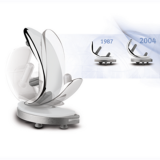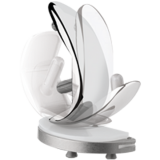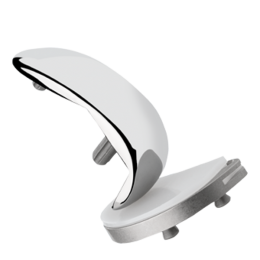Contraindications
The Zimmer Unicompartmental High Flex Knee System is designed to provide an early intervention option for patients with unresolved medial or lateral compartmental arthritis. Based on the successful design of the M/G® Unicompartmental Knee, the Zimmer Unicompartmental High-Flex Knee combines implant and instrument innovations with proven design concepts to create a reproducible knee system for today’s active patient population.
Clinical History
The Zimmer Unicompartmental High Flex Knee System is based on the established implant design of the M/GUnicompartmental Knee System, which has more than 15 years of clinical success.2 The combination of these proven design concepts and several new design innovations is already showing a reduced rate of revision in the Australian Orthopaedic Registry.
M/G Uni Clinical Survivorship

Yearly Cumulative Percent Revision of Primary Unicompartmental Knee Replacement3

Design Innovations
The Zimmer Unicompartmental High Flex Knee unites the proven design concepts of the M/G Uni with several new design innovations to meet the demands of today’s active patient.
Kinematics
Extended Posterior Condyle
- Safely accommodates high flexion up to 155°
Round on Flat Articulation
- Eliminates implant constraint and allows for +/- 8° of varus/valgus tilt without femoral point-loading on the polyethylene
Fixation
Two Optimally Positioned Femoral Pegs
- Femoral peg location changes by size for optimal fixation
Three Points of Tibial Fixation
- Two hourglass pegs and a rotational fin create a strong foundation for tibial fixation
Anatomic Replication
Comprehensive Sizing (with complete interchangeability)
- Seven femoral sizes, six tibial sizes, and tibial size specific articular surfaces in 1mm increments
Contoured Fit
- Anatomically shaped tibial and femoral components are designed to replicate the natural anatomy
System Versatility
The Zimmer Unicompartmental High-Flex Knee System adapts to a range of surgical approaches to satisfy specific surgeon preferences. This is accomplished with a single system of instruments that can be used with a spacer block, intramedullary, or extramedullary approach.
Bi-compartmental Compatibility
The Zimmer Unicompartmental High Flex Knee may also be used with the Gender Solutions® PFJ System giving the freedom to perform medial, lateral, and bi-compartmental surgical procedures.
Product Brochure
References
- Galante et al. The Progression of Patellofemoral Arthrosis after Medial Unicompartmental Replacement: Clinical Orthopedics and Related Research. 2004.
- Galante et al. Results of Unicompartmental Knee Arthroplasty at a Minimum of Ten Years of Follow-up. The Journal Bone Joint Surgery. 2005.
- Australian Orthopaedic Association National Joint Replacement Registry. Annual Report. Adelaide: AOA; 2009.
Indications
- Painful and/or disabling knee joints due to osteoarthritis or traumatic arthritis
- Previous tibial condyle or plateau fractures with loss of anatomy or function
- Varus or valgus deformities
- Revision of previous arthroplasty procedures
Contraindications
- Previous history of infection in the affected joint and/or local/systemic infection that may affect the prosthetic joint
- Insufficient bone stock on femoral or tibial surfaces
- Skeletal immaturity
- Neuropathic arthropathy
- Rheumatoid arthritis
- Obesity
- Varus/valgus deformities greater than 15 degrees
- Chondrocalcinosis
- Osteoporosis
- Damage to the articular cartilage of the opposite compartment
- Inflammatory synovitis
- Eburnated bone in the patellofemoral joint








